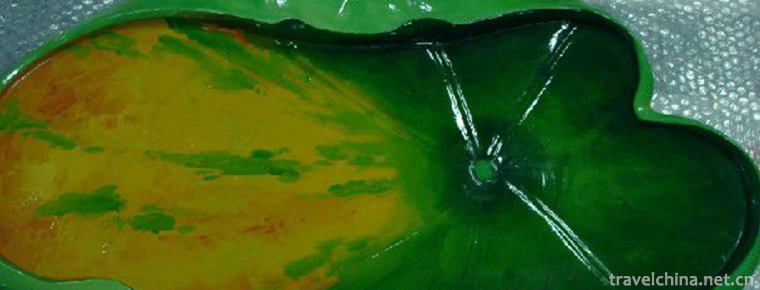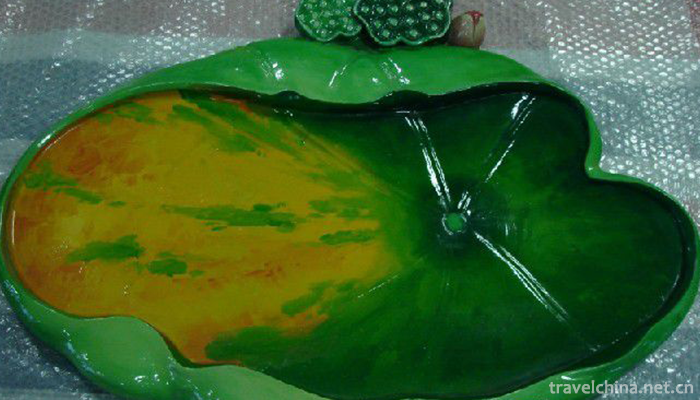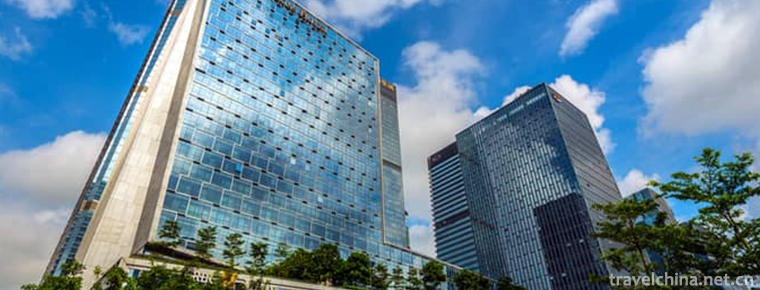2018-12-12

- By ChinaWiki.net
- Chinese Edition
- 2019-04-30
Fuzhou bodiless lacquerware decoration skills
Fuzhou bodiless lacquerware decoration technology, Fuzhou, Fujian Province, local traditional handicraft, one of the national intangible cultural heritage.
Fuzhou bodiless lacquerware decoration technology is a very special production process. It was founded on the basis of inheriting thousands of years of Chinese plant lacquer technology, using cloth or wood, after graying, polishing, manipulation, black polishing, color polishing and other processes, and then decorating with colored paint halo, brocade lines, vermilion painting gold, table flower insertion screw and other techniques, and finally finished production.
On May 20, 2006, Fuzhou bodiless lacquerware decoration technology was approved by the State Council and listed in the first batch of national intangible cultural heritage list, project number: _-54.
historical origin
Fuzhou bodiless lacquerware decoration technology was founded in the Qing Dynasty Qianlong period (1736 ~ 1795). Shen Shaoan, a famous lacquer artist, analyzed the ancient door plaques during his lacquer career. Why the inner wood had decayed, while the surface of the raw lacquer coated with Xia cloth (Ji Ma cloth) was intact. Therefore, on the basis of the traditional "pinch tyre" technology, the technology of bodiless decoration has been created. He used clay to sculpt the embryo of Buddha statue, then used Xia cloth and raw lacquer to cover many layers. After shade-dried lacquer, he poured out the dissolved mud and left a lacquer cloth tire. After many routes of graying, rubbing and painting, and then applying colors on the surface, he completed a light, solid and beautiful bodiless Buddha statue.
During the Daoguang period (1821-1850), Fuzhou, as a "five-port trading" port, increased overseas sales of bodiless lacquerware, which led to the emergence of Western-style crafts suitable for the aesthetic habits of Europeans and Americans: cigarettes, wine sets, coffee cups, vases, etc., and won the Gold Prize at the Paris International Expo. Shen Shaoan's descendants inherited and developed the skills of bodiless lacquerware. They paid tribute to the Qing Dynasty with exquisite crafts and were awarded the official post of "Four Goods Supporting Dai" by the court, which became a big news. Shen family's bodiless lacquerware has won various awards for the Oriental Fuzhou lacquer art in Panama, Chicago, Paris, Tokyo and Berlin expositions, becoming a large number of export crafts.
Since the 1950s, a large number of skilled talents of bodiless lacquerware decoration have emerged, and they have continuously innovated on the basis of inheriting the tradition. Works such as "Simu Wuding" and "Pumpkin Box" were exhibited at home and abroad, and were rated as "rare Oriental specialty" by international friends. Chairman Mao's Body Portrait, created in 1959, is as high as three meters, making it the largest work of art ever created.
In recent years, in order to better develop bodiless lacquerware and make it develop, Fuzhou has published a series of techniques of bodiless lacquerware in Fuzhou, established archives of lacquer artists, sorted out the unique skills of excellent authors and kept them on file, collected and published outstanding works with distinctive features, established a special issue of bodiless lacquerware in Fuzhou, established a computer database, set up a lacquer website, and improved and expanded lacquer. Art influence: and graft theoretical research and teaching practice, invite excellent experts and writers into colleges and universities, enter the classroom, popularize lacquer art in different forms such as lectures and lectures, train lacquer talents, establish training bases and practice places for bodiless lacquerware, carry out short-term training courses, creative improvement courses, find new people, and train a new generation of bodiless lacquerware authors. At the same time, the exchange and exhibition of lacquer art at home and abroad will be carried out to provide more opportunities for exchange and learning.
Process characteristics
Fuzhou bodiless lacquerware decoration technology, as the product of the combination of bodiless lacquer art and bodiless lacquer art, is very difficult in production. It combines bodiless lacquer art with bodiless lacquer exploration art. Moreover, from material selection to finished lacquerware, it has to go through dozens to hundreds of processes. Because of the complexity of the process, it takes quite a long time to make a lacquerware, so it often takes several months to make a lacquerware, and the finished product needs to be dried in the closed vagina for a long time.
Fuzhou bodiless lacquerware decoration technology is innovated on the basis of traditional Chinese lacquer color. In order to make the lacquer color more bright, the color of blue, green and Brown is specially added to the mixing material, which is mixed with gold powder and silver powder made from real gold and silver. In order to solve the drawbacks of common lacquer, such as blackening after drying, the color of Fuzhou bodiless lacquerware after this method of lacquer finish is more persistent. For a long time. The finished Fuzhou bodiless lacquerware looks gorgeous in color and has a mirror-like aesthetic feeling. Its shape is simple and elegant, generous and powerful. Its inlay contrast is strong, the foil cover is colorful, the paint exploration color is warm, polishing and moisturizing. There are also bright and beautiful, not afraid of water immersion, no deformation, no fading, strong, temperature, acid and alkali corrosion resistance and other advantages.
Inheritance and protection
Inheritance value
Fuzhou bodiless lacquerware is a wonderful flower of Chinese arts and crafts, the crystallization of the industrious wisdom of the Chinese people, and the treasure of Fuzhou folk crafts. It is of great value and significance to excavate, rescue and protect bodiless lacquerware in Fuzhou. The exquisite bodiless lacquerware has high aesthetic value. As the carrier of beauty, its art has the value of academic research.
In history, Fuzhou bodiless lacquerware was once collected as a palace treasure. After the founding of New China, it was listed as a precious national gift for foreign guests. It was favored by people at home and abroad. The products not only sold well in domestic provinces and cities, but also exported to more than 70 countries and regions in the world. People from all over the world have used such words as "precious black gemstone", "rare Oriental treasure", "light of decoration", "national treasure of the world" to describe the exquisite Fuzhou bodiless lacquerware.
Inheritance status
The Party and the government took timely rescue measures to set up Fuzhou No.1 and No.2 bodiless lacquerware factories on the basis of Shen Shao'anlan Ji and Deji. They also set up Fuzhou Institute of Arts and Crafts and Fuzhou School of Arts and Crafts to promote the development and prosperity of the lacquerware industry and make Fuzhou bodiless lacquerware not only surpass the past in production scale, but also in artistic style. Sampling.
Inheriting characters
Zheng Yikun, male, was born in October 1936. In June 2007, Zheng Yikun was selected as the representative successor of the first batch of national intangible cultural heritage projects and declared in Fuzhou, Fujian Province. Project Name: Fuzhou bodiless lacquerware decoration skills.
Huang Shizhong, male, was born on October 11, 1942. On December 20, 2012, Huang Shizhong was selected as the representative successor of the fourth batch of state-level intangible cultural heritage projects and declared in Fuzhou, Fujian Province. Project Name: Fuzhou bodiless lacquerware decoration skills.
Zheng Xiujun, male. 2018年5月16日,郑修钤入选为第五批国家级非物质文化遗产项目代表性传承人,福建省福州市申报。 Project Name: Fuzhou bodiless lacquerware decoration skills.
protective measures
In 2009, Fuzhou bodiless lacquerware was protected by national geographical indications.
In 2015, the Fuzhou Municipal Committee and the municipal government listed "the construction of Fuzhou lacquer culture brand" as one of the pilot tasks of Fuzhou's deepening reform.
On July 15, 2015, a training course for inheritors of intangible cultural heritage in China (Fuzhou bodiless lacquerware decoration skills) was held in Fujian Vocational College of Art.
social influence
Important exhibition
In 1994, the lacquer painting Still Life was selected for the 8th National Art Exhibition. In the same year, Lacquer Painting Goldfish participated in the Sino-Korean Lacquer Art Exchange Exhibition held in Seoul, Korea.
In 1998, Lacquer Painting "Rongcheng Ancient Bridge" participated in the World Lacquer Art Exhibition held in Taipei, China.
In 2002, Jinhui participated in the first national lacquer painting exhibition held in Xiamen, Fujian Province.
In 2003, Fuzhou bodiless lacquerware works participated in the "Chinese Contemporary Master Artists Exhibition" held in Kuala Lumpur, Malaysia. In the same year, works of bodiless lacquerware from Fuzhou participated in the "Four Masters of Chinese Arts and Crafts Exhibition" held in Fuzhou, Fujian Province.
Honorary commendation
In 1898, Fuzhou bodiless lacquerware works participated in the Paris International Exposition and won the gold medal.
In 1984, Zheng Yikun's work "Butterfly Dance in Spring and Qing Dynasty" won the first prize of National Hundred Flowers Award for Excellent Creation.
In 1986, Zheng Yikun's "Love in the Sea" won the first prize of National Hundred Flowers Award for Excellent Creation.
In 1986, Zheng Yikun's lacquer painting "Phalaenopsis" won the National Lacquer Painting Exhibition Excellent Works Award and was collected by the Soviet Oriental Art Museum.
In 1994, the lacquer painting Still Life was collected by the Chinese Art Museum. Lacquer painting "Entertainment" was published in Fujian Daguan Fujian Arts and Crafts.
In 1995, Lingbo Fairy, a large lacquer screen, was awarded the Excellent Technology Award for Interior Design in Fujian Hall and Taiwan Hall of the Great Hall of the People in Beijing.
In 1998, Lacquer Art "Fish Music Disk" was compiled into "Complete Works of Modern Chinese Art - Lacquer Art Volume". Lacquer Painting Still Life and Golden Fish were included in Complete Works of Modern Chinese Art, Lacquer Scroll.
In 1999, Lacquer Painting "Wish" won the Ninth National Art Exhibition Silver Award (China Museum of Art).
In 2000, Lacquer Painting "Wish" won the first prize of Fujian Art Creation in 1909 and was published in the second issue of "Art Observation". Lacquer painting "Wish" was awarded the second prize of the third "Hundred Flowers Award" in Fujian Province.
In 2001, the Chinese painting Untitled won the Best Works Award of the Famous Chinese Painters'Works Exhibition in the New Century.
In 2002, the Chinese painting "Yujie Bingqing" won the gold medal of the 2nd Wu Daozi Fine Arts Fund Exhibition.
In 2005, Lacquer Painting "Yue Yu Yu Tu" won the Gold Prize of the Second Community Culture and Art Festival of Fujian Province (Fuzhou, Fujian Province).

Ask a Question
Your email address will not be published.



0 Questions